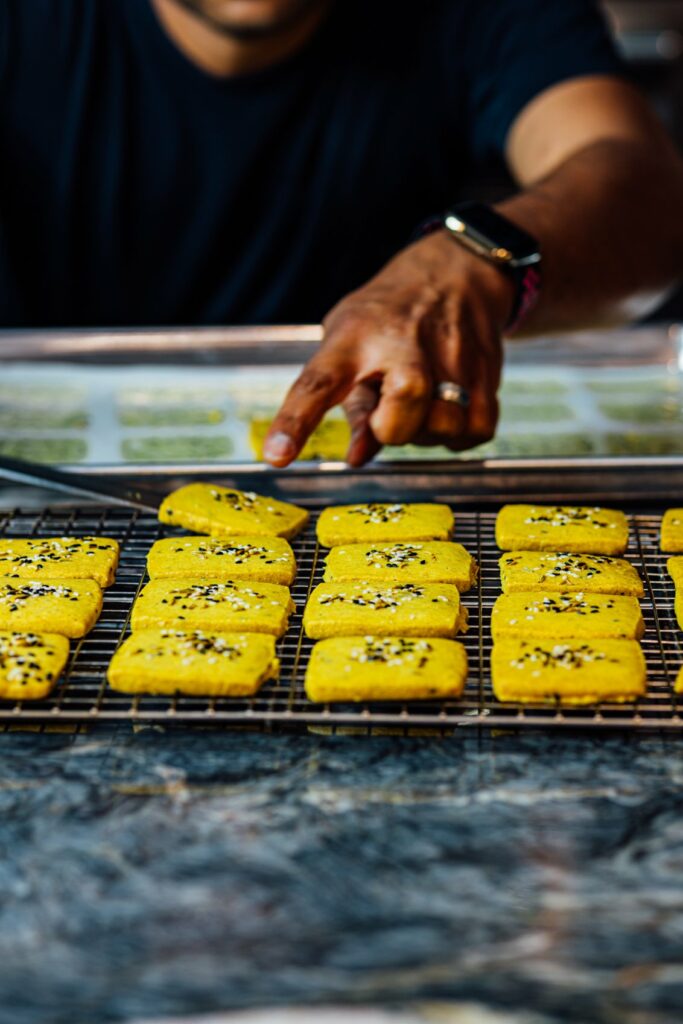
I am a sucker for teatime because it’s the perfect excuse to eat cakes and cookies. I’ve been reminiscing over the days when I would visit my grandparents in Bombay, India, and wait for the “biscuit man” to drop by in the afternoon with his tin boxes filled with cookies/biscuits. The cookies would come in various shapes, sizes, and flavors, and my favorites were the ones gently kissed with spices or the cookies sandwiched with a thick layer of fruit jam. Sometimes we’d walk through the neighborhood bazaar and visit the bakery to pick up fresh sweet buns stuffed with dried fruit or grab a cream horn. Teatime was a treat. As an adult, I don’t treat myself often with teatime, and perhaps if we had kids, I would repeat this tradition that was an integral part of my life. (I might be setting myself up for a dangerous situation here, my husband will probably read this and ask me to make him tea and cookies every evening.)
This shortbread is inspired by the sweet memories of those evening teas and delightful treats. There’s a hint of turmeric for color and a dash of warm spices for aroma. I’ve also thrown in a few sesame and fennel seeds that bring a crunchy bite and flavor. These also make a lovely gift to share with family and friends.
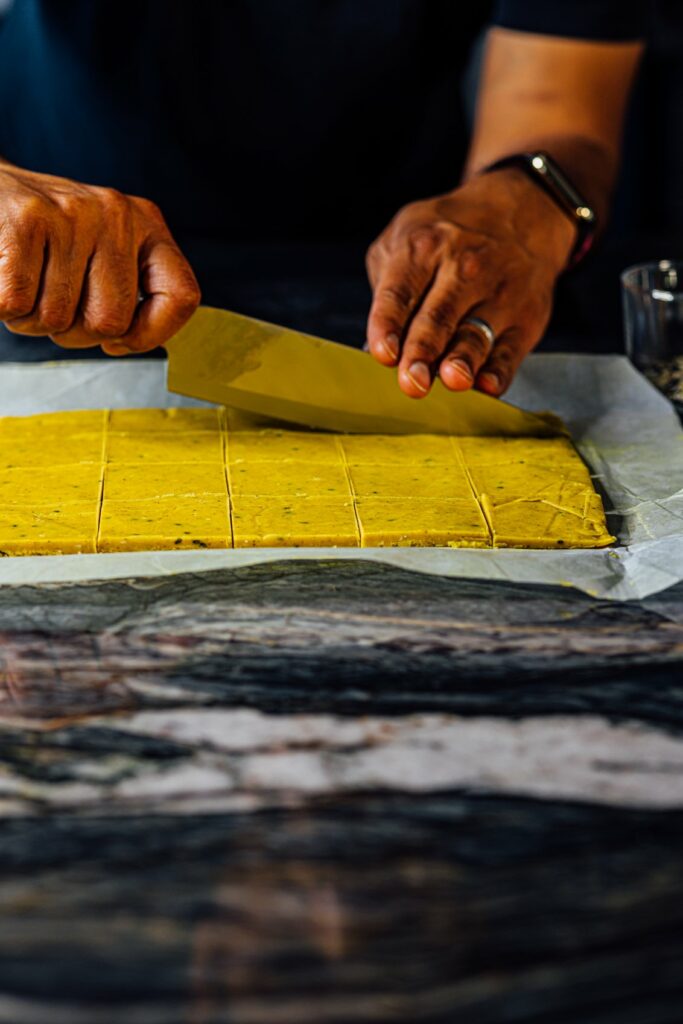
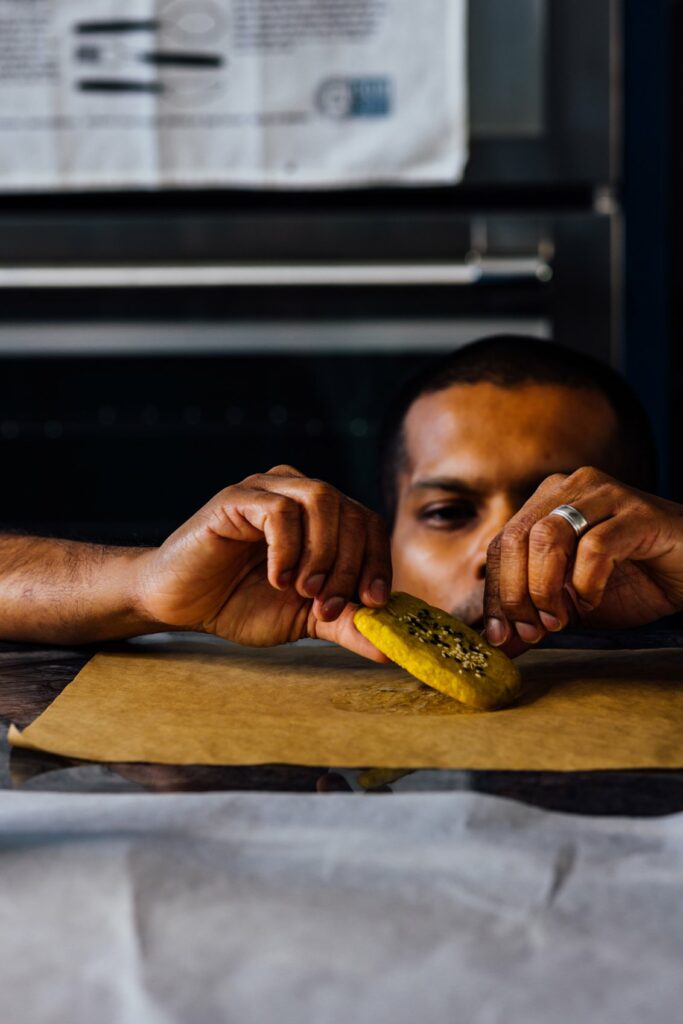
The Basics of Shortbread Making According to Science
Butter
Butter is an emulsified fat where water droplets are trapped inside the fat. The fat helps coat the gluten-forming proteins in the flour and prevents them from coming together. Any water from the butter that might encounter those proteins gets absorbed by the cornstarch (see below for how that works).
Hardboiled Yolk
Uncooked fresh egg yolk is about 50% water; during boiling, this water participates in the chemical and physical changes inside the egg and yolk proteins and phospholipids and is no longer readily available. As the egg and yolk proteins denature, the phospholipids change, and the yolk solidifies. These substances form a mesh and squeeze their water out.
Why does this matter? Water is an essential component of the gluten-forming reactions when the dough is prepared from flour. If a raw egg yolk were used in this recipe, there would be greater gluten formation because the water from the yolk is much more readily available. In a hardboiled yolk, that water is lost. The cooked yolk provides the necessary fat for the cookie structure without the water.
Confectioners’ Sugar
When it comes to sugar and texture, the size of the sugar crystals matters; larger crystals take longer to dissolve and produce crunchier textures. For cakes and desserts, bakers often rely on superfine sugar’s/caster sugar’s tiny-sized crystals to dissolve faster and make tender and more delicate crumbs. Confectioners’ sugar/icing sugar is ground down to a tiny size (smaller than superfine sugar), and if you look at the crystal sizes below, you’ll see what I mean.
Sugar Crystal Size Comparisons
Coarse Sugar 700 to 1400 µM
Granulated Sugar 450 to 650 µM
Superfine Sugar/Caster Sugar 150 to 450 µM
Confectioners’ Sugar/Icing Sugar 10 to 40 µM
Cornstarch is pure starch, and when added to flour, it reduces the amount of gluten formed by sitting between the gluten-forming proteins. While mixing the batter, cornstarch hydrates by binding water, making it unavailable for gluten production. This is also why cornstarch makes a quick cake flour substitute; it helps create a more tender crumb.
Temperature
Cooler temperatures slow down the formation of gluten, which helps us achieve a better shortbread texture. Freezing and refrigerating the dough often during the prep steps will give us another backup in your quest to reduce gluten formation.
Now it’s time to bake!
Sources Consulted
Karl F. Tiefenbacher, Chapter Ten – Glossary of Terms in Wafers, Waffles and Adjuncts, Editor(s): Karl F. Tiefenbacher, The Technology of Wafers and Waffles II, Academic Press, 2019, Pages 325-411.
The Ritz Carlton London Cookbook – Mitchell Beazley
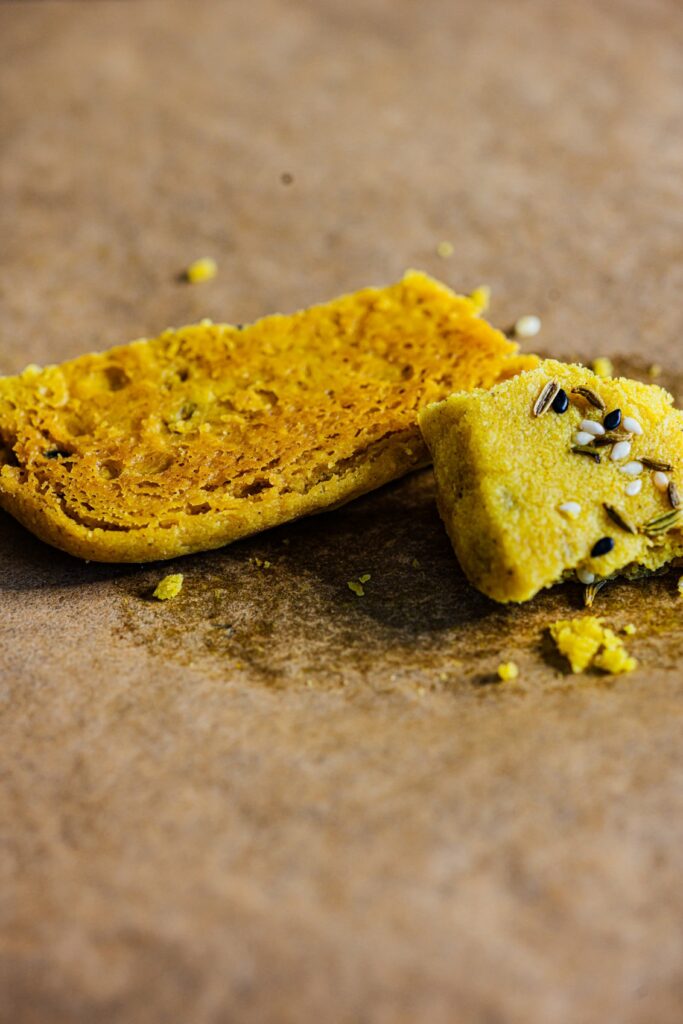
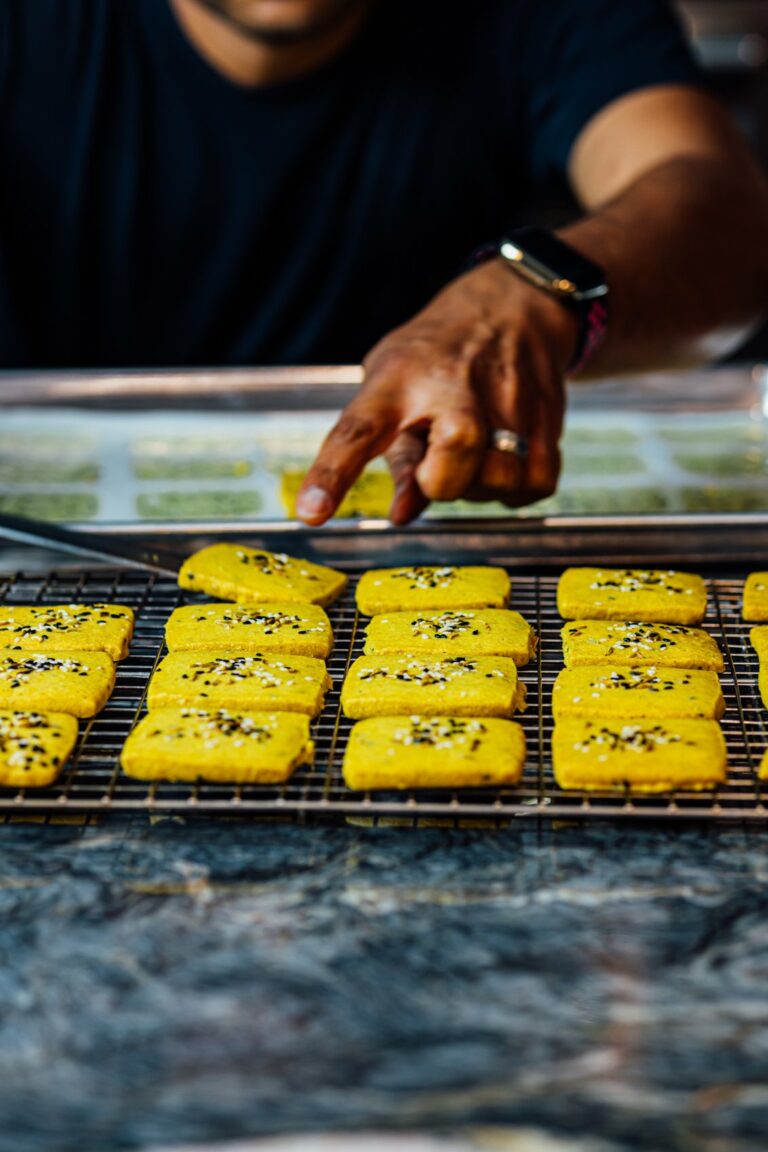
Spiced Golden Shortbread Cookies
5 Stars 4 Stars 3 Stars 2 Stars 1 Star
4.7 from 3 reviews
These shortbread cookies are buttery and crisp, will melt in your mouth, and they’re inspired by the different spiced cookies baked and served in India during teatime. Turmeric gives them a burst of golden sunshinelike tint, while the addition of spices gives them an irresistible fragrance. I’ve also added sesame and fennel seeds for a little crunch and nutty flavor.
- Yield: 24 cookies each 2 in/5 cm square
Ingredients
1 Tbsp black sesame seeds
1 Tbsp white sesame seeds
1 Tbsp fennel seeds
1 ¼ cups/210 g all-purpose flour
¼ cup/35 g cornstarch
½ tsp ground black pepper
½ tsp ground ginger
½ tsp ground green cardamom
½ tsp ground cinnamon
½ tsp ground turmeric
8 oz/230 g unsalted butter, softened to room temperature
⅔ cup/80 g confectioner’s sugar
1 yolk from a large hardboiled egg
⅛ tsp fine sea salt
Instructions
- In a small bowl, mix the sesame and fennel seeds.
- In a medium bowl, dry whisk the flour, cornstarch, black pepper, ginger, cardamom, cinnamon, and turmeric.
- Using the paddle attachment, beat the butter and sugar over low speed until pale and fluffy, 5 to 6 minutes. Scrape down the sides and bottom of the bowl using a bowl scraper. Place the yolk in a fine-mesh strainer held over the bowl of the mixer and press the yolk with a spoon until it completely passes through and transforms into fine shavings. Add the salt and beat over medium speed until combined, 1 minute. Scrape down the sides and bottom of the bowl using a bowl scraper. Add the dry whisked flour mixture to the creamed ingredients in the bowl, and mix over medium-low speed until combined, 2 to 3 minutes. Scrape down the sides and bottom of the bowl using a bowl scraper. Add ½ of the seed mixture to the shortbread dough and mix over low speed for 1 minute, until evenly dispersed. Reserve the remaining seeds in the bowl for the shortbread topping.
- Transfer the shortbread dough to a sheet of parchment paper. Roll and shape into an 8 in by 12 in/20 cm by 30.5 cm rectangle. Transfer the rolled-out dough with the parchment paper onto a baking sheet, top with a second sheet of parchment paper or cling wrap, and freeze for 1 hour or up to 2 hours.
- Bring the baking sheet with the rolled-out dough and transfer the parchment paper with the cookie dough onto the kitchen counter. Unwrap and reserve one sheet of parchment paper. Using a sharp knife trim the edges (you can skip this and leave the edges untrimmed), score the rolled-out dough, and cut into 2 in/5 cm squares. Line the same baking sheet with a sheet of parchment paper. Transfer the cut squares of dough to the parchment paper, spacing them out evenly using an offset spatula (I left a ⅜ in/1 cm space). If the dough warms up and softens and makes it tricky to transfer them to the baking sheet, stick them in the freezer uncovered for 15 minutes to firm up. Sprinkle the reserved sesame and fennel seeds on top of the cookies. Take one of the reserved sheets of parchment paper, place it over the cookies, and gently press the seeds down to stick to the cookie dough’s surface. Unwrap and return the sheet to the freezer for 15 minutes to firm up.
- When ready to bake, preheat the oven to 300°F/150°C.
- Once the cookies firm up, bake them on the baking sheet in the preheated oven, rotating the pan halfway through during baking, until the edges just start to turn golden brown, 30 to 40 minutes. Remove from the oven and let the cookies rest on the baking sheet for 5 minutes, transfer to a wire rack and let cool completely. Store the cookies in an airtight container for up to 1 week.
Notes
- Confectioner’s sugar and cornstarch are light, can blow with the wind and sudden movements, and make a mess. When weighing, adding, and mixing them, execute caution; combine them slowly, saving you from later cleaning a giant dust cloud.
- Scrape the sides and the bottom of the bowl as often as possible to ensure the ingredients mix evenly. Invest in a bowl scraper if you don’t own one. Because of their curved design, bowl scrapers do a much better job than silicone spatulas at reaching the deeper curved sides of the bowl.
- To grate a hardboiled egg yolk, sift it.
- Refrigerate the uncooked dough as often as possible to help create a crispier shortbread cookie.
- If you have a ravioli roller on hand, use that to get a fancier edge on the cookies, but a sharp knife and a cookie cutter also work. I prefer keeping it simple because cookie cutters come in odd shapes and tend to create extra work (you’ll have to collect the dough scraps and roll it out again, increasing the amount of gluten, and the second batch might not be as crispy).
- These cookies are sweet enough for most people, however, dust them lightly with confectioner’s sugar if you like them sweeter.
- Author: Nik Sharma

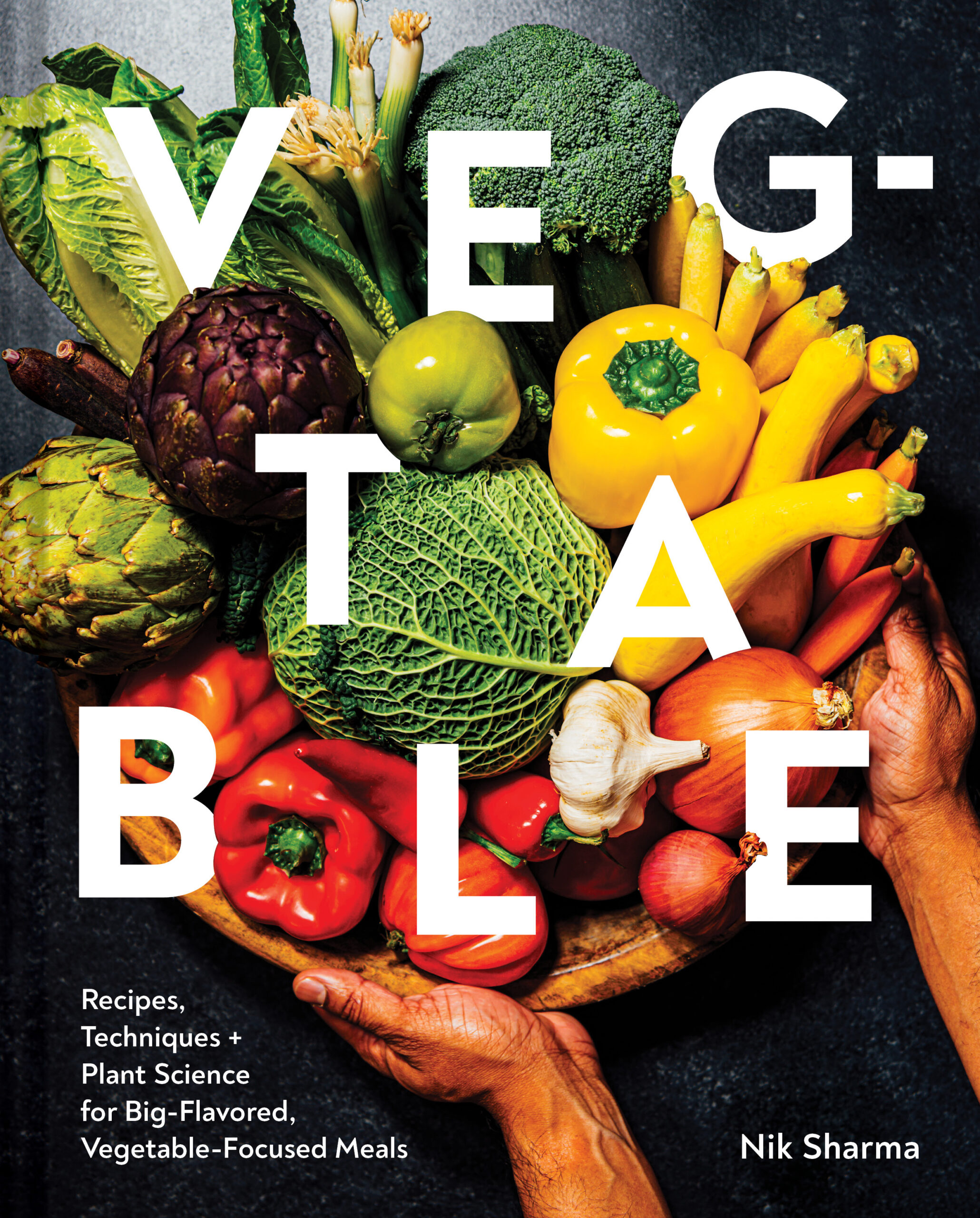
15 Responses
I’m very intrigued! I will be making these soon ! Thanks for sharing your knowledge!
Yay! I hope you love the cookies.
Hi there! There’s a Portuguese cookie that also uses hard boiled yolks!
I need to make it, do you remember what it’s called?
I just pulled my first batch of these cookies out of the oven and they are sublime. Beautiful spiced flavor and not too sweet (didn’t add confectioner’s sugar to top because I didn’t find it necessary). Great shortbread texture though next time I’d cut back on the baking time by just a bit. 25 minutes in my oven would be fine. I’ve made a lot of shortbread and this is going to become one of my favorites.
Why only 4 stars? Well, it has nothing to do with the result of the recipe, and this is just personal to me, but it drives me nuts when a recipe instruction says “put on a sheet tray and place in the freezer”.
It makes me wonder if professionals sometimes forget what it’s like to try to reproduce their recipes in a home kitchen. I don’t know about anyone else but the only freezer space I have is those two awkwardly shaped bins in the bottom of my refrigerator. There’s no way a half-sheet pan is going to fit in there. Every once in a while I have enough freezer space for a quarter sheet pan if I move everything to the other side, but not very often. So unless I improvise I can’t follow the recipe as written.
So instead of using the freezer I did the following: After making the dough I dumped it onto a sheet of parchment and patted it into a rectangle about 10×6. I put another sheet of parchment on the top and rolled the rectangle to about 12 x 8. Then I moved enough stuff around in my refrigerator to put the dough on a half sheet pan to chill it. It took about 5 hours to get firm enough to sprinkle with seeds, roll them in, slice, re-chill for 20 minutes, and bake. Next time if I have room for a quarter tray in the freezer, I’ll roll the dough to fit on that, freeze it, roll it out bigger, and go from there.
Again, the cookies are absolutely spectacular. I’ll also try a bit more spices next time as cardamom ended up being a bit predominant, but that’s another personal preference thing.
Thank you!
My freezer is configured differently than yours but there is no way I can fit a half sheet pan in there.
There’s an easy workaround. Use a smaller plate/tray to fit your freezer.
I’m looking forward to making these for the holidays! Is it a good ideas to toast the sesame seeds and fennel before using?
Hi Michelle, I strongly advice against doing that because those spices are going to toast during baking.This will lower the amount of aromatic essential oils and they go bad faster with each round of extra toasting.
Thoughts on using saffron instead of turmeric?
Obviously, a different flavor but the idea intrigues me.
Why not! Try it out, it’s used in desserts and cookies in India.
Getting ready to make these. Definitely intrigued with the idea of using the hard-cooked egg yolk. I’m sure I’ll love it as so many of your recipes have become cornerstones in my cooking.
Over the years I’ve gone to grinding more-and-more whole spices as I need them. Initially I used various Microplanes (especially the little tube-shaped one which is wonderful for nutmeg), but last year finally purchased a dedicated electric spice grinder. I not only have nutmeg, cloves, peppercorns, … but also dried ginger corms, mace blades, and (ta da!) decorticated green cardamom. I’ve been eyeballing the amounts of the whole spices — but now I’m beginning to wonder if I should be measuring the whole spices by weight to get a more accurate weight. btw, I found this as a starting point for dry weight: https://www.shamrockfoodservice.com/wp-content/uploads/2018/05/DrySpiceConversions.pdf Sadly, it’s ounces, but that’s why we have spreadsheets.
So there must be a question here somewhere. I know that the freshly ground spices definitely boost the flavor level. Should I be using less — and would you be able to suggest how much less? Or just go w/the original amounts and revel in the spice?
Hi, Nik! Didn’t notice until after I’d cut them up, but it seems you may have the dimensions of these cookies wrong — I followed the 1-inch square directions, which has of course resulted in 96 very small cookies. Then I took a closer look at the photos + predicted number of servings and realized you must have meant 2×2 inch cookies (which would indeed yield 24 cookies). Going to take a guess at baking time and hopefully have some amusingly tiny cookies to enjoy, but thought you might want to know!
Oh yikes, thanks for letting me know, you’re absolutely right!
O.M.G I love shortbread cookies in all forms but these are the lightest, crispest, most melt-in-your-mouth ever!!
(Had to freeze some to keep from eating the whole batch at once.)
Will be making again and again and again……
BTW using saffron instead of turmeric is a definite win! I used 1/2 tsp (ish, they didn’t want to stay in the spoon) threads and then ground them and bloomed in 1 tsp water. I omitted the fennel seeds as I didn’t want to overpower the saffron.